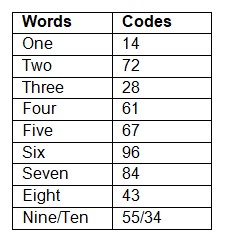Question
If the code for “Nine Power” is “34 89”, then
what is the code for the phrase “Ten Eight Power” in the given code language? Study the following information carefully and answer the questions given below. In a certain code language, ‘Three Two One Four’ is coded as ‘72 28 14 61’ ‘One Seven Five Six’ is coded as ‘96 14 84 67’ ‘Two Five Eight One’ is coded as ‘43 67 72 14’ ‘Four Nine Six Ten’ is coded as ‘55 96 34 61’Solution

Match the following stadiums with their alternate names:
Which Article of the Indian Constitution empowers Indian Parliament to amend the constitution?
Which Five-Year Plan was based on the "P.C. Mahalanobis Model"?
Consider the following statements about the Mahatma Gandhi National Rural Employment Guarantee Act & Scheme:
1. It guarantees a minimum of 100 da...
The place where the United Nations Charter was signed is
Which of the following statements in the context of the Central Vigilance Commission (CVC) is correct?
Which of the following Article is known as ‘The very soul of the Constitution’ by Dr.B.R.Ambedkar?
With reference to Overseas Citizen of India (OCI) Cardholder, consider the following statements:
1. A citizen of another country who was a citize...
Under the Indian Constitution, 'livestock and animal husbandry' fall under which list?
Under which Article of the Constitution of India can the President take over the administration of a state, in case its constitutional machinery breaks ...
Relevant for Exams:


